 The dream turned into a nightmare the evening of April 8, 2000, at a dusty desert airfield near the southeastern Arizona town of Marana. The Marine and Air Force pilots and maintainers of the Multiservice Operational Test Team, the MOTT, had begun the Osprey’s most important stage of testing yet, Operational Evaluation, five months earlier. The results of OPEVAL would determine whether the Osprey could go into Full Rate Production, so the aviation branch at Headquarters Marine Corps was paying close attention. The Marine Corps’ Deputy Commandant for Aviation, Lieutenant General Fred McCorkle, had visited Paxtuxent River Naval Air Station on November 3, 1999, to kick the tests off. On April 8, the MOTT’s four Ospreys – two carrying the Marine infantry in the back – took off from Yuma, Arizona, for an exercise called a ‘Noncombatant Evacuation Operation’ simulating the rescue of civilians from an embassy. Marines would play the role of evacuees. Marana Northwest Regional Airport, 25 miles northwest of Tucson, would play the embassy.
The dream turned into a nightmare the evening of April 8, 2000, at a dusty desert airfield near the southeastern Arizona town of Marana. The Marine and Air Force pilots and maintainers of the Multiservice Operational Test Team, the MOTT, had begun the Osprey’s most important stage of testing yet, Operational Evaluation, five months earlier. The results of OPEVAL would determine whether the Osprey could go into Full Rate Production, so the aviation branch at Headquarters Marine Corps was paying close attention. The Marine Corps’ Deputy Commandant for Aviation, Lieutenant General Fred McCorkle, had visited Paxtuxent River Naval Air Station on November 3, 1999, to kick the tests off. On April 8, the MOTT’s four Ospreys – two carrying the Marine infantry in the back – took off from Yuma, Arizona, for an exercise called a ‘Noncombatant Evacuation Operation’ simulating the rescue of civilians from an embassy. Marines would play the role of evacuees. Marana Northwest Regional Airport, 25 miles northwest of Tucson, would play the embassy. The MOTT had done similar missions before. But this time, after the first two aircraft approached the airfield and tilted their rotors upward to land, the second Osprey snapped into a right roll and plowed into the ground with its belly up. It exploded in a fireball that lit the evening sky for miles. The pilots, Major John A. “Boot” Brow and Major Brooks S. “Chunky” Gruber, as well as two enlisted crew chiefs and fifteen infantry riding in the back of their Osprey, were killed instantly. The first Osprey, piloted by Major James M. “Lefty” Wright and Major Anthony J. “Buddy” Bianca, was nearly lost as well. Wright, Bianca, three enlisted crew chiefs and eighteen Marine infantry in the back of their Osprey survived a hard landing that left them shaken.
The MOTT had done similar missions before. But this time, after the first two aircraft approached the airfield and tilted their rotors upward to land, the second Osprey snapped into a right roll and plowed into the ground with its belly up. It exploded in a fireball that lit the evening sky for miles. The pilots, Major John A. “Boot” Brow and Major Brooks S. “Chunky” Gruber, as well as two enlisted crew chiefs and fifteen infantry riding in the back of their Osprey, were killed instantly. The first Osprey, piloted by Major James M. “Lefty” Wright and Major Anthony J. “Buddy” Bianca, was nearly lost as well. Wright, Bianca, three enlisted crew chiefs and eighteen Marine infantry in the back of their Osprey survived a hard landing that left them shaken.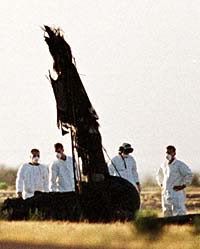 Three days after the crash, McCorkle came to the Pentagon press briefing room to give the media the first of what he promised would be regular updates as the investigation into what had happened at Marana progressed. “Right now we have no indication of what caused the accident,” McCorkle said. “I’ve heard on a number of news reports that we were looking at pilot error. We are not. We’re looking at anything that caused the accident, whether it’s material, whether it’s mechanical, or whether it was human factor-related. And right now we have none of that information.” McCorkle stiffened a touch when a reporter asked if he’d heard that the parents of some of the infantry killed were saying the Marines had used their sons as “guinea pigs” in a test aircraft, a machine that “was unsafe and their child had communicated that to them.”
Three days after the crash, McCorkle came to the Pentagon press briefing room to give the media the first of what he promised would be regular updates as the investigation into what had happened at Marana progressed. “Right now we have no indication of what caused the accident,” McCorkle said. “I’ve heard on a number of news reports that we were looking at pilot error. We are not. We’re looking at anything that caused the accident, whether it’s material, whether it’s mechanical, or whether it was human factor-related. And right now we have none of that information.” McCorkle stiffened a touch when a reporter asked if he’d heard that the parents of some of the infantry killed were saying the Marines had used their sons as “guinea pigs” in a test aircraft, a machine that “was unsafe and their child had communicated that to them.”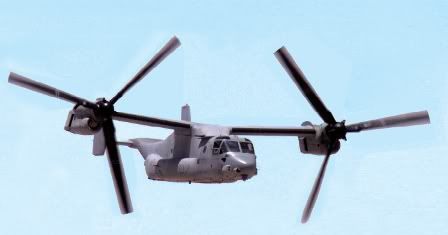 The Ospreys at Marana were “in no way test aircraft,” McCorkle said, they were production models the Marines would be flying in operational squadrons for years to come. He had flown the Osprey himself, and his confidence in it was unshaken. “I consider this to be the best aircraft that I’ve ever been in. This accident, to me, is not going to do anything to our MV-22 program.”
The Ospreys at Marana were “in no way test aircraft,” McCorkle said, they were production models the Marines would be flying in operational squadrons for years to come. He had flown the Osprey himself, and his confidence in it was unshaken. “I consider this to be the best aircraft that I’ve ever been in. This accident, to me, is not going to do anything to our MV-22 program.”McCorkle reported to the Pentagon press briefing room on May 9 to confirm, as CNN had reported five days earlier, that the crash investigators had found nothing wrong with the Osprey. McCorkle described how the accident had enfolded. The pilots had missed their 3,000-foot checkpoint and begun their approach into the airfield late. Rather than wave off and go around, they had come down “high and hot,” forcing the pilots to follow in what none seemed to sense was a pell mell descent. The data showed that the mishap aircraft was in a high rate of descent at a relatively low forward airspeed. These characteristics can lead to a condition known as power settling or vortex ring state.
Here Be Dragons
An MV-22B Osprey lands outside the city of Marjah, Afghanistan in February. Photo by Lance Cpl. Justin Loya
 With that, McCorkle introduced a new, and for many people occult-sounding term into the debate over the Osprey, “Vortex ring state” was esoteric not only to the general public but in the aviation world as well. It was a term from fluid mechanics, an expression even an aeronautical engineer could go a career without hearing very often. Vortex ring state described a condition a rotor could get into as a result of what Navy and Marine Corps pilots called “power settling” and Army and Air Force pilots knew as “settling with power.” What it all amounted to was a way to describe a rotor that was no longer creating thrust and lifting as it should because it was descending into its own downwash too quickly.
With that, McCorkle introduced a new, and for many people occult-sounding term into the debate over the Osprey, “Vortex ring state” was esoteric not only to the general public but in the aviation world as well. It was a term from fluid mechanics, an expression even an aeronautical engineer could go a career without hearing very often. Vortex ring state described a condition a rotor could get into as a result of what Navy and Marine Corps pilots called “power settling” and Army and Air Force pilots knew as “settling with power.” What it all amounted to was a way to describe a rotor that was no longer creating thrust and lifting as it should because it was descending into its own downwash too quickly.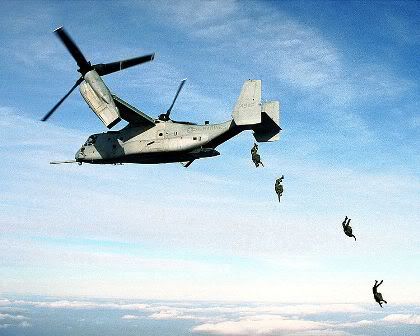 A rotor creates thrust both by pushing air downward and by pulling air through the ‘rotor disk’ the circle a rotor’s blades describe as they rotate. At the tips of the blades, some downwash circles back over top of the rotor disk and is pulled back through. This disturbed air interferes with a motor’s ability to create thrust only minimally – unless the rotor descends into its own downwash at the same velocity the downwash is moving. In that case, most or all of the downwash recirculates through the rotor disk rather than racing downward faster than the rotor and creating thrust. The downwash is now churning in a ‘vortex ring’, an air flow pattern seen in smoke rings, and the rotor has entered ‘vortex ring state’. When a rotor goes into vortex ring state, it no longer creates the thrust it should, and the aircraft begins to descend faster than the pilot wants.
A rotor creates thrust both by pushing air downward and by pulling air through the ‘rotor disk’ the circle a rotor’s blades describe as they rotate. At the tips of the blades, some downwash circles back over top of the rotor disk and is pulled back through. This disturbed air interferes with a motor’s ability to create thrust only minimally – unless the rotor descends into its own downwash at the same velocity the downwash is moving. In that case, most or all of the downwash recirculates through the rotor disk rather than racing downward faster than the rotor and creating thrust. The downwash is now churning in a ‘vortex ring’, an air flow pattern seen in smoke rings, and the rotor has entered ‘vortex ring state’. When a rotor goes into vortex ring state, it no longer creates the thrust it should, and the aircraft begins to descend faster than the pilot wants.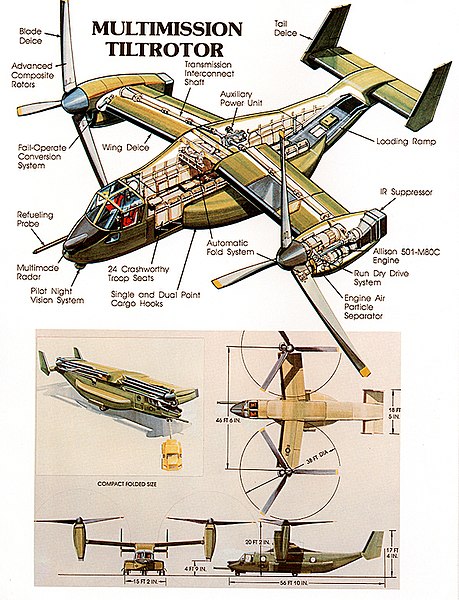 When an aircraft descends too quickly, a pilot’s natural tendency is to add power to arrest the descent, but in vortex ring state, adding power produces the opposite of the desired effect. In a rotorcraft, adding power also adds pitch to the rotor blades, increasing the angle at which they hit the air. Adding power and pitch to a rotor in vortex ring state only creates more disturbed air and pulls it back through the rotor disk faster. Instead of flowing as it should and creating thrust, the air begins bouncing in and around the rotor disk chaotically and the aircraft loses lift even faster. Helicopter pilots are taught about the hazard and told that the best way to get out of it is to reduce power to slow the rotor while flying into ‘clean air’ by tilting their helicopter’s nose forward.
When an aircraft descends too quickly, a pilot’s natural tendency is to add power to arrest the descent, but in vortex ring state, adding power produces the opposite of the desired effect. In a rotorcraft, adding power also adds pitch to the rotor blades, increasing the angle at which they hit the air. Adding power and pitch to a rotor in vortex ring state only creates more disturbed air and pulls it back through the rotor disk faster. Instead of flowing as it should and creating thrust, the air begins bouncing in and around the rotor disk chaotically and the aircraft loses lift even faster. Helicopter pilots are taught about the hazard and told that the best way to get out of it is to reduce power to slow the rotor while flying into ‘clean air’ by tilting their helicopter’s nose forward.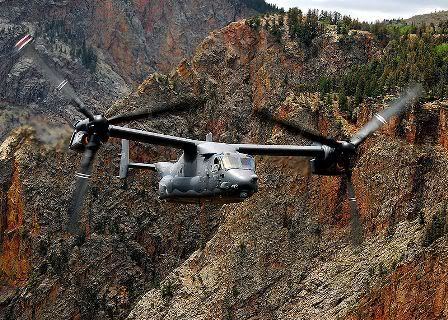
That tilts the rotor forward and increases forward airspeed. Without sufficient altitude, through, there may be too little time to do that, so pilots are urged simply to steer well clear of vortex ring state by never descending too quickly at slow speeds. It’s the rotary wing aviation equivalent of an ancient cartographer writing on a map “Here Be Dragons”. Helicopter pilots learn the rule and avoid that edge of the flight envelope out of habit. The simply don’t go there. The rule of thumb for most helicopters is to avoid descending faster than 800 feet per minute when flying forward at 40 knots or less. Where the actual line existed for the Osprey was something the program’s developmental test pilots hadn’t determined. Hundreds of test flights to explore that part of the Osprey’s envelope had been planned.
 Years later Nolan Schmidt, program manager and a Marine Corps colonel at the time said that those tests were scrapped in 1998 to save time and money. The Navy Department was going to cut the Osprey program’s budget for the coming fiscal year by $100 million. After consulting with the Boeing engineer in charge of flight testing the program managers decided they could save $50 million and a lot of time if they didn’t do all the tests planned for the Osprey at high rates of descent. A few tests already done had indicated that the Osprey could safely descend at 1,200 feet per minute below 40 knots airspeed. It was enough to know there were dragons lurking beyond a descent rate of 800 feet per minute at 40 knots or less, so why test?
Years later Nolan Schmidt, program manager and a Marine Corps colonel at the time said that those tests were scrapped in 1998 to save time and money. The Navy Department was going to cut the Osprey program’s budget for the coming fiscal year by $100 million. After consulting with the Boeing engineer in charge of flight testing the program managers decided they could save $50 million and a lot of time if they didn’t do all the tests planned for the Osprey at high rates of descent. A few tests already done had indicated that the Osprey could safely descend at 1,200 feet per minute below 40 knots airspeed. It was enough to know there were dragons lurking beyond a descent rate of 800 feet per minute at 40 knots or less, so why test?At his May 9 briefing, McCorkle was asked whether the Osprey that crashed had been ‘descending within the flight envelop’.
“He was descending over a thousand feet per minute,” McCorkle said, noting that the recommended limit was no more than 800 feet per minute at 40 knots or less. Why the pilot had descended so fast was still being studied. The right rotor of the Osprey might have gone into vortex ring state only when the pilot moved his control stick to the right four seconds before the crash, that may have been what caused it., McCorkle said.
The main thing McCorkle wanted understood was that the crash wasn’t being blamed on a flaw in the Osprey.
The Right Stuff
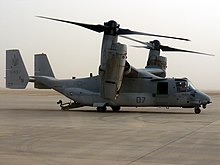 Once upon a time, test pilots like the famed Chuck Yeager tugged on a helmet and squeezed into a flight suit, strapped on an x-molded aircraft, then bet their lives they could find the edge of its envelope without having to punch out or ride the experimental machine into the ground. Those days are long gone. Today’s test pilots still fly to the edge of the envelope. The still need ‘the right stuff’ – steady nerves, quick reflexes, maybe a little swagger in their walk. They still climb into new or modified aircraft and try things no one else has ever done with them. Today’s test pilots, though, no longer routinely fly into the unknown. They don’t even fly as often they work on the ground. A test pilot today is more likely to be found manipulating a keyboard and mouse than a stick and throttle. He - they are still mostly men – is less likely to be sitting in a cockpit than in a meeting with engineers or at a desk, analyzing data and planning flight tests in meticulous detail.
Once upon a time, test pilots like the famed Chuck Yeager tugged on a helmet and squeezed into a flight suit, strapped on an x-molded aircraft, then bet their lives they could find the edge of its envelope without having to punch out or ride the experimental machine into the ground. Those days are long gone. Today’s test pilots still fly to the edge of the envelope. The still need ‘the right stuff’ – steady nerves, quick reflexes, maybe a little swagger in their walk. They still climb into new or modified aircraft and try things no one else has ever done with them. Today’s test pilots, though, no longer routinely fly into the unknown. They don’t even fly as often they work on the ground. A test pilot today is more likely to be found manipulating a keyboard and mouse than a stick and throttle. He - they are still mostly men – is less likely to be sitting in a cockpit than in a meeting with engineers or at a desk, analyzing data and planning flight tests in meticulous detail.Each step in a modern test flight is scripted on a ‘test card’, which is carried on a clipboard strapped to the pilot’s knee for easy reference while airborne. After a flight, the pilot writes a detailed report, which he and the engineers will go over in yet another meeting. The report may rely in part on tape recordings of observations the pilot spoke into a microphone as he flew. It will certainly rely on data gathered during the flight by onboard instruments that instantly and constantly record not only the machine’s altitude, speed, pitch, yaw, roll, and other motions but its every moan and groan. Today, pilots ‘fly’ dangerous tests first in SUV-sized machines that mimic real flight with astounding fidelity, yet without ever leaving the ground. Based on calculations fed into their computers, simulators can be programmed to replicate how an aircraft will behave in almost any circumstance. Flying the aircraft itself is the only way to prove the calculations were correct, betting their lives when they go out and fly.
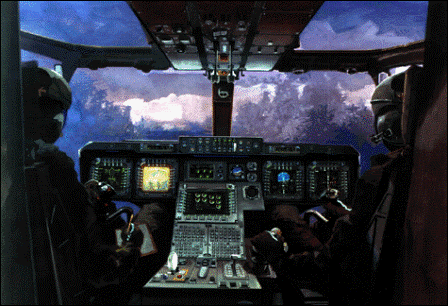
The Osprey’s High Rate of Descent tests were an exception to that rule. The pilots who flew them would venture into that region on the map marked ‘Here Be Dragons’. You could die there.
The HROD tests would be dangerous because vortex ring state was largely a mystery. The phenomenon was hard to describe, much less predict, partly because so little research had been done in it in the six-decade history of the helicopter. Beyond that, no one had ever devised an entirely reliable way to predict all the air flows created by rotors. Like the weather, there was a nearly infinite number of variations that could affect them. The flows around a rotor, which moves in a circle but might be stationary or moving forward or backward or sideways as it rotates, are devilishly more complex. This makes engineering rotor-craft an art as well as a science. The pilots and engineers in the Osprey program were certain the aircraft’s high disk loading made it far less likely to go into vortex ring state than critics assumed. The only way to prove it, though, was to take an Osprey aloft and go find its vortex ring state boundary. Based on calculations and the tests done in 2000, the engineers and pilots were confident an Osprey could get out of vortex ring state simply by tilting its rotors into clean air. If they were wrong, though, someone could die trying.
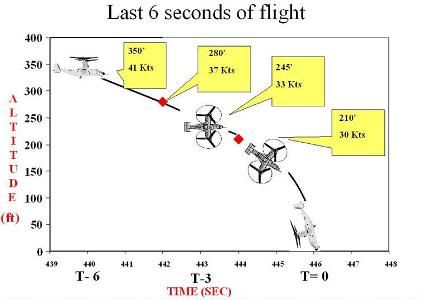 For the planned second series of HROD tests, only two pilots would be aboard; there was no reason to risk more lives by having engineers or crew chiefs in the back. The tests began only six months after the Osprey’s return to flight. From November 2002 to July 2003, 62 HROD tests were performed, flying a total of 104 hours over a restricted flight range. They would climb to 10,000 feet, then tilt the rotors up into helicopter mode and slow to a target airspeed. While the pilot held it there for a bit, a challenge in itself, the copilot would put his hands on his own set of controls, just in case. To duplicate the way the Osprey that crashed at Marana had been flying, the pilot would lower the landing gear, tilt the nacelles back to 95 degrees, and start reducing power. The Osprey would begin to drop. The pilot would let it fall until they hit a target rate of descent, then adjust the power to hold the Osprey at a steady sink rate. At that point, still descending, the pilot and his copilot would talk into their microphones about the Osprey’s stability and handling, the quality of the ride, and whether they heard anything unusual. They were looking for ways a pilot might detect the onset of vortex ring state before getting into it. They repeated the flight profile over and over during those months, taking their measurements at every 500-foot increment of sink rate at a series of ever slower airspeeds.
For the planned second series of HROD tests, only two pilots would be aboard; there was no reason to risk more lives by having engineers or crew chiefs in the back. The tests began only six months after the Osprey’s return to flight. From November 2002 to July 2003, 62 HROD tests were performed, flying a total of 104 hours over a restricted flight range. They would climb to 10,000 feet, then tilt the rotors up into helicopter mode and slow to a target airspeed. While the pilot held it there for a bit, a challenge in itself, the copilot would put his hands on his own set of controls, just in case. To duplicate the way the Osprey that crashed at Marana had been flying, the pilot would lower the landing gear, tilt the nacelles back to 95 degrees, and start reducing power. The Osprey would begin to drop. The pilot would let it fall until they hit a target rate of descent, then adjust the power to hold the Osprey at a steady sink rate. At that point, still descending, the pilot and his copilot would talk into their microphones about the Osprey’s stability and handling, the quality of the ride, and whether they heard anything unusual. They were looking for ways a pilot might detect the onset of vortex ring state before getting into it. They repeated the flight profile over and over during those months, taking their measurements at every 500-foot increment of sink rate at a series of ever slower airspeeds.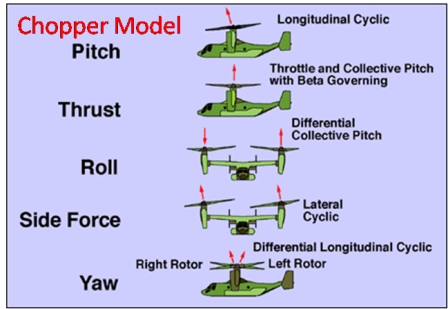
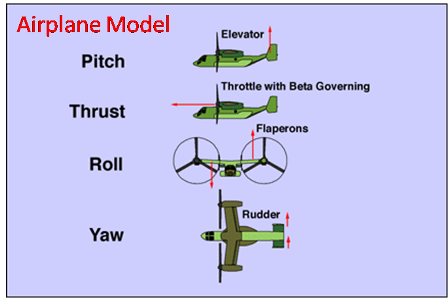
As predicted, they found it hard to put the Osprey into vortex ring state. The boundary for a helicopter was a sink rate somewhere around 800 feet per minute at 40 knots or less of forward speed. The pilot and copilot weren’t actually trying to lose control of the Osprey, they were just trying to find the edge of the envelope, the point where they felt vortex ring state coming on. They got there a number of times without incident. The pilot said that a little up and down motion would settle into the aircraft that they weren’t communicating. The Osprey would rock a little bit in some cases, and at the lowest speeds they tested, as slow as 10 knots forward speed while plunging toward the ground, the pilots would hear an eerie howling and audio sound of the air rush. They would just get really silent and quiet. Eleven times during the tests, one of the rotors went into vortex ring state and the Osprey did a sudden, uncommanded roll – seven times to the right, four times to the left. Each time, the pilot was able to recover by pushing the thumbwheel switch to tilt the nacelles forward and put the rotors into undisturbed air. Two seconds was usually all it took. Those two seconds gave the pilots some hairy moments though.
Sink Rate, Sink Rate
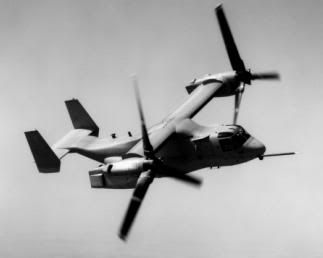 The hairiest was on July 17, 2003. The tests already had achieved their primary goal – charting the Osprey’s envelope for vortex ring state – a couple months earlier. Based on that envelope, the program had developed warning devices for the Osprey to alert pilots when they were flirting with vortex ring state. One was visual, a red light on the control panel in front of each pilot that would flash SINK, SINK if an Osprey exceeded a safe rate of descent. The other was a recording of a woman – device pilots call a ‘Bitching Betty’ who would be heard in the pilot’s headset saying, “sink rate, sink rate” in an urgent monotone if the limit were exceeded. On July 17, they were flying 7-10 knots and descending at more than 2,300 feet per minute, well beyond the vortex ring state envelope already established. The pilot was on the radio with an engineer on the ground when the Osprey suddenly snap-rolled right more violently than the pilot had ever seen it do. Instinctively, he pushed the stick left as the roll began but the Osprey didn’t respond. By the time the pilot recognized what was happening, the Osprey was flying on its side, left wing up and right wing down, and spiraling toward the ground even faster. The pilot pushed the thumbwheel to tilt the nacelles forward as fast as they would go, all the way to airplane mode. The seconds it took seemed like minutes, but finally he regained control and straightened the Osprey out. For a moment, there was silence in the cockpit and over the radio. They all knew the pilots had just had a close call. If the Osprey had rolled all the way upside down in helicopter mode, there was no telling what damage they might have done to the aircraft – or whether they could have regained control at all.
The hairiest was on July 17, 2003. The tests already had achieved their primary goal – charting the Osprey’s envelope for vortex ring state – a couple months earlier. Based on that envelope, the program had developed warning devices for the Osprey to alert pilots when they were flirting with vortex ring state. One was visual, a red light on the control panel in front of each pilot that would flash SINK, SINK if an Osprey exceeded a safe rate of descent. The other was a recording of a woman – device pilots call a ‘Bitching Betty’ who would be heard in the pilot’s headset saying, “sink rate, sink rate” in an urgent monotone if the limit were exceeded. On July 17, they were flying 7-10 knots and descending at more than 2,300 feet per minute, well beyond the vortex ring state envelope already established. The pilot was on the radio with an engineer on the ground when the Osprey suddenly snap-rolled right more violently than the pilot had ever seen it do. Instinctively, he pushed the stick left as the roll began but the Osprey didn’t respond. By the time the pilot recognized what was happening, the Osprey was flying on its side, left wing up and right wing down, and spiraling toward the ground even faster. The pilot pushed the thumbwheel to tilt the nacelles forward as fast as they would go, all the way to airplane mode. The seconds it took seemed like minutes, but finally he regained control and straightened the Osprey out. For a moment, there was silence in the cockpit and over the radio. They all knew the pilots had just had a close call. If the Osprey had rolled all the way upside down in helicopter mode, there was no telling what damage they might have done to the aircraft – or whether they could have regained control at all.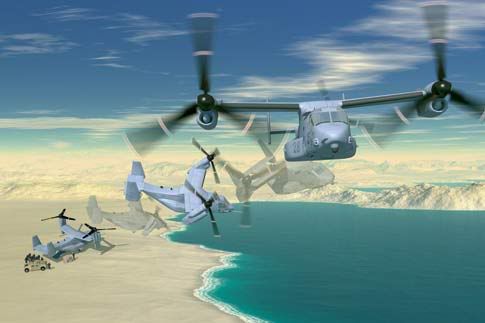
After landing the Osprey, it was decided they had taken the HROD testing of the Osprey far enough. The Osprey’s boundary for vortex ring state had been established beyond any doubt, and studied more than that of any rotorcraft in the world. The pilot, Tom MacDonald (Osprey program’s chief test pilot), was awarded the Society of Experimental Test Pilots highest honor, the Iven C. Kincheloe Award for “outstanding professional accomplishment.” The pilot had flown every flight in a test program where no test pilot has been before.
http://www.fas.org/programs/ssp/man/uswpns/air/rotary/v22osprey.html
http://www.zpub.com/notes/osprey.html
http://tucsoncitizen.com/veteranveritas/2010/04/07/memorial-for-marines-killed-in-osprey-accident/
http://www.marana.com/index.aspx?NID=332
http://www.angelfire.com/me/swissair111memorial/modded/ThatVexingVortexRing.html
http://www.angelfire.com/me/swissair111memorial/modded/mccorkle.htm